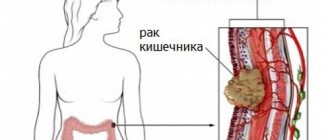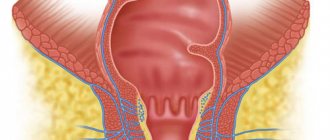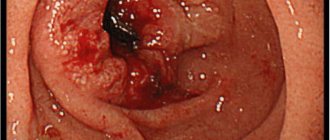What is colorectal cancer?
Rectal cancer is a tumor degeneration of the epithelial cells of the mucous membrane of any part of the rectum, which has all the signs of malignancy and cellular atypia. This means that such a tumor exhibits the usual properties of malignant neoplasms, namely: rapid and infiltrative growth with penetration into surrounding tissues, a tendency to metastasize, and frequent relapses after treatment. Modern oncologists combine rectal cancer with colon cancer into one group and call it colorectal cancer. The disease is equally common among men and women in the age range from 40 to 75 years. Prevalence – 16 cases per 100 thousand population per year.
Despite its frequent occurrence, this type of cancer pathology ends with a favorable outcome much more often than other cancers. This is due to the fact that the anatomical location of the primary tumor in rectal cancer is accessible to diagnosis in the early stages of development. To detect a tumor, the doctor only needs a simple digital examination or an endoscopic examination if there is the slightest complaint. In addition, most cases of early stages of rectal cancer (with the exception of low-lying forms) can be easily removed surgically and are quite sensitive to radiation and chemotherapy.
When planning treatment tactics and making prognoses for specific cases of rectal cancer, we are guided by several of its most important characteristics:
- Zone of growth in the rectum:
- Rectosigmoid region - tumor at a height of more than 12 cm from the anus;
- Upper ampullary - tumor at a height of 8 to 12 cm from the anus;
- Medium ampullary - tumor at a height of 4 to 8 cm from the anus;
- Inferior ampullary section – from the dentate line to 4 cm;
- Anal cancer – the tumor is located within the anus;
- Type of cancer growth:
- Exophytic – into the lumen of the rectum in the form of a tumor node;
- Endophytic - the tumor grows through the wall of the organ and protrudes slightly into its lumen;
- Infiltrative - cancer that quickly involves all the tissues located around the rectum in the tumor process, in the form of an inflammatory conglomerate;
- Presence of metastases:
- Damage to the peri-rectal lymph nodes;
- Metastases in the pelvic tissue;
- Involvement of para-aortic and inguinal lymphatic collectors;
- Distant metastases in the liver, lungs and other organs;
- The degree of histological differentiation of the cancerous tumor:
- Poorly differentiated – grows slowly and rarely metastasizes;
- Highly differentiated - very quickly shows all the signs of malignancy;
- Moderately differentiated - occupies an intermediate position between the previous types of cancer.
Life expectancy with colorectal cancer
Statistics for colorectal cancer are not always optimistic, but they are much better than for other types of malignant tumors:
- Despite the availability of diagnostics, detection of the disease at stages 1-2 does not exceed 20%. Approximately the same number of patients already have metastases in the lymph nodes and internal organs;
- In most patients (about 60-70%), the disease is detected at stage 3;
- On average, about 60% of patients survive the 5-year mark after treatment;
- Five-year survival rates for stage 4 rectal cancer have not been reported. The average life expectancy of such patients is from 3 to 9 months;
- The life expectancy of patients with an established diagnosis of high-grade, low-grade rectal cancer at stages 1-2 is the highest and is measured in decades;
Life expectancy for rectal cancer depends on many characteristics: structure, type of growth and location of the tumor. But the most important factor is early diagnosis of the disease, which increases the chances of a further full life tenfold!
On the subject: Selenium reduces the risk of cancer by 2 times!
Therapy methods
To eliminate the first signs of rectal cancer in women or men, any oncological techniques are used. The choice of specific therapy depends on the depth of the affected cells. The main way to eliminate all symptoms of colorectal cancer in women and men is surgery. But this technique is effective if the cancer process is at stage 1-2. In other cases, complex treatment is prescribed, including:
- various types of radiation therapy;
- surgery;
- polychemotherapy.
Before treating rectal cancer with surgery, the doctor takes into account the area of the organ affected. If cancer is detected in the area of intestinal obstruction, unloading transferzostomy is performed. If the patient's condition has stabilized, the malignant tumor of the rectum is removed.
To treat cancer in the area of the rectosigmoid flexure, obstruction is indicated. It is possible to cure a tumor in the mid-ampullary region with anterior resection. If necessary, subsequent lymph node dissection and removal of pelvic tissue are performed. To restore the continuity of the organ, a primary anastomosis is performed.
Treatment of rectal cancer in the lower ampullary region is aimed at extirpation of the organ. After removal, the sphincter remains. A tumor in the anorectal area is removed by extirpation. In this case, the closure apparatus and lymph nodes are cut out.
Chemotherapy and diet
Treatment of rectal cancer and prevention of its recurrence involves chemotherapy. The technique involves infusions using a combination of antitumor chemotherapeutic agents (Leucovorin, Oxaliplatin). Such treatment is indicated if it is impossible to remove the tumor. This technique can be combined with surgery. If before surgery metastases are detected in the lymph nodes or liver, chemotherapy is carried out periodically, but for a long time.
For colorectal cancer, treatment includes diet. It is recommended to follow a nutritious and balanced diet. The patient should avoid spicy and fatty foods, smoked foods, and canned food.
At an early stage, you can use folk remedies. There are medicinal plants with antitumor properties:
- milestone - this poisonous plant contains the substance cicutoxin. But if you use the plant in a small concentration, then a therapeutic effect is observed. More often, a tincture is prepared from vekha and celandine;
- celandine – used for various forms of colon cancer. It is recommended to drink one hour after tincture of Vekha. Additionally, a microenema based on celandine is given. This complex treatment quickly reduces inflammation, reducing swelling;
- burdock root - 3 tbsp. l. The plants will need a glass of boiling water. The finished product is diluted with water;
- soda - prepare a water-soda solution for an enema;
- cabbage - juice from the vegetable is mixed with beet juice. You can add honey to the resulting product;
- St. John's wort tincture: at st. l. raw materials - a glass of boiling water;
- Hemlock is a poisonous plant from which the tincture is prepared. Hemlock leaves and flowers are poured with vodka. Take 2-3 drops in the morning, washed down with water;
- alder cones – to prepare the decoction, you will need to boil the cones with water;
- calendula - the flowers of the plant are infused with medical alcohol. The product is drunk, first diluted with water;
- Plantain juice - a plant collected in the spring, is crushed and mixed with sugar. The resulting mass is used in 1 tbsp. l. 4 times a day;
- wormwood infusion - 2 tbsp. l. raw materials take 500 ml of boiling water. The composition is infused for 30 minutes;
- Propolis is a universal remedy that effectively relieves the symptoms of colorectal cancer. Propolis tincture diluted with warm milk is taken 2 times a day.
Symptoms of colorectal cancer
Rectal cancer does not show specific symptoms for a long time. The situation is aggravated by the fact that when symptoms appear, patients often do not pay attention to them. After all, more than 75% of such people have a burdened history of pathology of the rectum and anal canal (chronic hemorrhoids, paraproctitis and rectal fistulas, anal fissure and itching, proctitis of various origins). Therefore, perceiving the true symptoms of cancer as another exacerbation of his chronic disease, a person seeks help only when the symptoms listed in the table occur.
| Group of symptoms | Detailed Specifications |
| Discharge from the rectum |
|
| Bowel irritation |
|
| Intestinal obstruction |
|
| General symptoms |
|
The first symptoms of colorectal cancer
The whole difficulty of early diagnosis of rectal cancer lies in the nonspecificity of its first manifestations. Usually these are symptoms that every person periodically observes.
Therefore, with regard to rectal cancer, you should always be on guard:
- The initial appearance of any of the symptoms characteristic of this disease and their long-term persistence (weakness, low-grade fever, loss of weight and appetite, constipation, discomfort in the rectal area);
- Progression of symptoms characteristic of any diseases of the rectum, if there is a history of them;
- The appearance of any discharge, especially with blood. Patients with chronic hemorrhoidal bleeding must note their intensity and the nature of the blood released, which changes with rectal cancer;
- The first symptoms of the disease in the form of intestinal obstruction or severe bleeding always indicate late stages of the tumor process.
Features of intestinal dysfunction
Such disorders include a whole group of individual symptoms. They appear as:
- constipation;
- diarrhea;
- false urge to defecate.
Rectal cancer is characterized by alternating diarrhea and constipation. These signs can be attributed to the earliest manifestations of the disease. As the size of the malignant tumor increases, constipation becomes more common. As a rule, they can last for 1 - 2 days, however, sometimes the side effects last for weeks. At one point, constipation suddenly gives way to diarrhea.
False urge to defecate is observed quite often at the very beginning of tumor formation. After the onset of this symptom, the patient increasingly wants to go to the toilet, however, when attempting to defecate, feces are not released. Sometimes defecation occurs in the form of a small amount of pus and mucus. This phenomenon is typical for the early stages of cancer, but due to the fact that people most often suffer from the disease in old age, few people pay attention to this manifestation. With age, digestive processes are disrupted, which is why in old age false urges to defecate are considered normal, rarely causing concern in patients.
Signs of colon cancer
The clinical picture of rectal cancer, consisting of complaints and objective signs of the disease, is based on the data given in the table.
| Feature group | Detailed Specifications |
| Data from digital rectal examination |
|
| Abdominal palpation data |
|
| General data of objective examination |
|
In the early detection of rectal cancer, the leading place belongs not to the symptoms of the disease, which are noticed by the patient himself, but to objective signs. Therefore, preventive medical examinations are a truly effective method for diagnosing rectal cancer in the early stages!
Medical indications
The rectum is located in the pelvic area and is the last segment of the large intestine. The causes of colorectal cancer have not been identified. But the factors that provoke the disease have been established:
- poor nutrition;
- heredity;
- passive life;
- smoking and alcoholic drinks;
- inflamed intestines.
Colorectal cancer does not appear for a long time. Common symptoms of the disease include pale skin, unexplained fatigue and lethargy. With rectal cancer, discharge of a different nature appears. In the early stages, the intestines may become irritated. In this case, the following symptoms arise:
- periodic abdominal pain;
- discomfort in the lower abdomen;
- sensation of a foreign object in the intestine;
- feeling of false bowel movement.
If the patency of the organ is impaired, bloating may occur. Symptoms of rectal cancer include:
- constipation;
- rumbling with pain;
- gas retention.
The first stage is characterized by a nonspecific manifestation of the disease. This makes early diagnosis of the cancer process difficult. The first symptoms of rectal cancer should alert the patient:
- constipation, discomfort in the rectal area;
- worsening symptoms;
- various secretions.
Clinical picture
In the early stages, the doctor takes into account objective signs. Therefore, preventive medical examinations help diagnose colorectal cancer in the early stages of its development. Experts include the results of a digital examination of the affected organ as similar signs:
- detection of a tumor or deformation of the mucosa;
- exophytic tumor has a short or long stalk;
- with the endophytic-infiltrative form, the intestinal lumen narrows;
- at stage 4 there is acute paraproctitis.
After a finger examination, traces of stool with blood or brown discharge remain on the medical glove. What signs can be detected for rectal cancer by palpating the abdomen? In this case, the following symptoms are observed:
- at stages 1-2, the abdomen is unchanged;
- a large tumor localized in the rectosigmoid region is easily palpable;
- late cancer process is accompanied by bloating and tympanitis;
- at the last stage, damage to the rectum by cancer is manifested by high tympanitis.
Doctors include the following objective general data in a separate group:
- patient weight loss;
- pale skin with a yellow tint;
- covering the tongue with a white coating.
Stages of the disease
Colon cancer is characterized by stages, which are based on the following characteristics of the disease:
- size of the primary tumor;
- penetration of cancer into the wall and lumen of the organ;
- involvement of other organs in the cancer process;
- metastases in the lymph nodes;
- metastases in other organs.
What is the initial cancer process? The occurrence of the disease in question at the first stage is the appearance of an ulcer or small tumor. The neoplasm is mobile and has clearly defined areas of mucosa. Given the degree of spread, the cancer does not penetrate deeper than the submucosa. There are no distant or regional metastases.
Rectal cancer in men, detected at the second stage, is characterized by neoplasms that spread to the mucous membrane of the organ. Moreover, they are located within the lumen and its wall. There are no metastases. If the pathology occurs at stage 2B, then metastases appear in the regional lymph nodes. The primary neoplasm has dimensions corresponding to stage 2A.
At stage 3A, the size of the tumor exceeds 1/2 the diameter of the circumference of the rectum. The pathology involves the walls of the organ and adjacent tissue. At this stage, single metastases in the lymph nodes can be detected. At stage 3B, multiple metastases appear.
Causes of rectal cancer
The main causes of colorectal cancer include:
- Immune imbalance in the body, in which immune surveillance cells responsible for eliminating tissues with signs of cellular atypia are unable to provide antitumor protection. Against this background, defective cells of the rectal epithelium, constantly formed in the process of mucosal renewal, remain unnoticed. As a result, they further multiply in the form of a tumor. This mechanism of colorectal cancer is usually combined with other causative factors;
- Precancerous conditions of the mucous membrane of the rectum and anal canal. These include any chronic diseases of the anorectal area: hemorrhoids, paraproctitis, rectal fistulas, chronic anal fissure, chronic proctitis and proctosigmoiditis, Crohn's disease and UC (ulcerative colitis). The initiation of tumor growth in this case is caused by a disruption of the process of normal cell division caused by their long-term damage;
- Single large polyps or polyposis of the colon and rectum. The presence of benign growths of the mucous membrane in the form of tumor-like thickenings is accompanied by their constant growth. In this case, there is an extremely high risk of malignancy of polyps with their transformation into a cancerous tumor;
- Carcinogens. These include chemicals (nitrates, pesticides, industrial poisons and emissions), ionizing radiation, food (the predominance of meat dishes, fast food, cholesterol and animal fats in the diet), oncogenic viruses. Carcinogenesis is structured in such a way that any of the carcinogens causes direct damage to the genetic material of the cells of the rectal mucosa, or affects indirectly through the formation of toxic products of lipid peroxidation. Cells with damaged DNA in the p53 gene locus, which triggers apoptosis (automatic death of a tumor cell), turn out to be immortal and multiply in the form of a tumor;
- Genetic predisposition. A family history of colorectal cancer is one of the main risk factors for the development of this disease in first-degree relatives.
See also: Other causes of cancer and risk factors
Causes of the disease
First of all, you need to give due importance to your diet. A proper healthy diet will help keep the intestinal microflora in good shape, maintain normal fecal formation and stool frequency. In addition, eating a large amount of meat will also not bring anything good. As stated earlier, animal fats have a bad effect on the condition of the digestive tract system. This is all explained by the fact that meat products are considered heavy food; they linger in the intestines for a relatively long time, and the walls of the rectum are under constant influence of bacteria.
So-called carcinogens appear; they may also be contained in the food itself. That is why the form of cancer under discussion is almost never found among representatives of vegetarian culture. Not only meat can affect the condition of the rectum. In general, frequent consumption of fried or too fatty foods can provoke the disease. The functioning of the liver is disrupted, and dysbacteriosis appears.
Another reason for the development of this disease is a decrease in physical activity. This can include sitting for a long time in an office chair, and simply an overly passive lifestyle. Therefore, even if you constantly work sitting within four walls, try to walk in the fresh air as often as possible, walk.
The third factor may be pre-existing rectal problems and untreated diseases. This can include hemorrhoids, polyps, inflammatory processes and other pathologies. The root cause may also be constant constipation, which a person is not used to taking into account. Anal sex is also a common cause. If a partner is infected with any inflammatory disease (it may not necessarily be sexually transmitted), then the risk of developing rectal cancer increases significantly. These are the main sources of the disease.
In children, the cause may be: Hereditary polyposis of the colon Gardner's syndrome Various forms of ulcers Surgeries on the intestines
Stages of rectal cancer
Classification of rectal cancer depending on the stage of the tumor process is based on the following characteristics of the disease:
- Size of the primary tumor;
- The extent of the tumor in relation to the intestinal wall and lumen;
- Involvement of adjacent organs in the tumor process;
- The presence of metastases in the lymph nodes;
- The presence of metastases in distant organs.
All these signs coincide with the TNM classification of rectal cancer. The stage reflects only a combination of different degrees of indices of each of the components of this abbreviation (from the first to the fourth degree, for example - T2N1M0). Isolation of the stage of the disease should be intertwined with the necessary treatment tactics.
Stage 1 rectal cancerStage 1 is spoken of if the cancer in the form of a tumor or ulcer is small in size, mobile, and occupies a clearly limited area of the mucous membrane. According to the degree of distribution, it does not penetrate deeper than the submucosal layer. Regional and distant metastases are not determined. |
Rectal cancer stage 2Stage 2A is determined if the cancer spreads to an area from 1/3 to 1/2 of the circumference of the mucosa, but is located strictly within the intestinal lumen and its wall. There is no metastatic lesion; Stage 2B. The fundamental difference of this stage is that there are already metastases in the regional paraintestinal lymph nodes. The primary tumor is similar in size to stage 2A or smaller. |
Rectal cancer stage 3Stage 3A – the tumor occupies more than half the circumference of the rectum. The depth of germination is characterized by the involvement of the entire wall of the organ and peri-rectal tissue in the tumor process. In this case, single metastases are recorded in the lymph nodes of the first order. Stage 3B. The size and depth of tumor spread are any. In this case, multiple metastatic foci are recorded in all rectal lymphatic collectors; |
Rectal cancer stage 4Stage 4 can be represented by either a tumor of any size in the presence of distant metastases in the internal organs and lymph nodes, or a disintegrating tumor with destruction of the rectum and growth through the surrounding tissue of the pelvic floor in combination with regional metastases. |
Cancer classifications
In oncology, to evaluate the tumor and determine further treatment tactics, there is a TNM classification. T – denotes the tumor, its size; N – characterizes damage to the lymph nodes; M – indicates the presence and absence of distant metastases.
If we talk about rectal cancer, then according to T the following degrees of tumor growth are distinguished:
- 1 – submucosa;
- 2 – muscle layer;
- 3 – subserous membrane and the nearest parts of the colon;
- 4 – spread outside the organ, damage to the peritoneum, compression of other formations.
When assessing the lymph nodes, that is, N, the following grades are distinguished:
- 1 – damage to less than 3 nearby lymph nodes;
- 2 – damage to more than 3 nearby lymph nodes.
If tumor cells are found in lymphatic formations located far from the rectum, then they speak of distant metastases. In addition, the appearance of atypical cells in any part of the body other than the primary lesion automatically means that rectal cancer is at stage 4, regardless of its size and the number of affected lymph nodes.
Symptoms of rectal cancer in women and men will also depend on the macroscopic form of the tumor process. The following types are distinguished:
- Exophytic (grows into the intestinal lumen);
- Transitional or saucer-shaped (has an oval shape, raised edges and a flat bottom);
- Endophytic (grows into the intestinal wall).
Disease prognosis
The outcomes of colorectal cancer can be predicted based on the following data:
- Stages of the disease;
- Type and degree of tumor differentiation;
- Age and general condition of the patient;
- The presence of concomitant pathologies;
- Timeliness, adequacy and effectiveness of the treatment provided.
Depending on this, the prognosis for rectal cancer may be as follows:
- Cancer of the anal canal and lower ampullary rectum has the worst prognosis even at stages 1-2, as it requires disabling surgery and often recurs. Such patients are forced to use colostomy bags for life;
- Poorly differentiated tumors always have a much more favorable prognosis compared to tumors with a high degree of differentiation of cancer cells;
- Prognosis for life and recovery is significantly aggravated by old age, concomitant diseases and disorders of the general condition of patients. These factors not only limit the possibilities for performing radical surgery, but also accelerate the progression of the tumor process;
- The survival rate of patients in relatively satisfactory general condition with stage 1-2 cancer ranges from 60% to 85%;
- For stage 3 tumors in patients with relatively good health, survival for 5 years after diagnosis, subject to radical treatment, is about 30%;
- With stage 4 cancer, the prognosis for life is unfavorable. Almost all patients die within 6-8 months.
- Refusal of radical treatment of operable forms of cancer of any stage has an unfavorable prognosis and ends in death within a year.
Main causes
A malignant tumor affecting the tissues of the rectum is considered a common pathology, which is often diagnosed in middle-aged men and women. Survival and full recovery depend on the stage at which the disease was recognized and treated. Early detection has the most beneficial effect on forecasts. After successful therapy, patients live a long time and go about their daily activities. Otherwise, it becomes impossible to cure oncology. Due to weakening and intoxication of the body, the patient dies within a few months.
Rectal cancer develops under the influence of such negative factors:
- hereditary predisposition;
- chronic inflammatory diseases of the anorectal area;
- untimely bowel movements;
- polyposis;
- abuse of bad habits;
- sedentary lifestyle;
- infection with human papillomavirus;
- unfavorable environmental conditions;
- elderly age.
Rectal metastases
Rectal cancer tumors with a high degree of cell differentiation are most prone to metastasis. Even their small size does not exclude the presence of distant metastatic foci.
Favorite sites for metastasis of such tumors:
- Regional, pelvic and retroperitoneal lymph nodes;
- Liver;
- Lungs and pleura;
- Hollow abdominal organs and peritoneum;
- Brain;
- Flat bones and spine.
Primary distant metastases in 95% of patients appear in the liver. At the same time, it increases in size and becomes denser, which manifests itself as discomfort and heaviness in the right hypochondrium. As new metastases grow and appear, they gradually replace the liver tissue, which impairs the functional abilities of the liver and manifests itself as yellowing of the skin.
The second most common type of distant metastases is considered to be damage to the peritoneum, which is called carcinomatosis. As a result of its irritation and impairment of functional abilities, ascites forms with the accumulation of a huge amount of ascitic fluid. Similar changes occur in the pleural cavity in the presence of pleuropulmonary metastasis. In this case, one- or two-sided hydrothorax is noted.
On the subject: Immunity by 243% - a new generation of immunomodulatory agents
Diagnosis of rectal cancer
Directions and methods for diagnosing rectal cancer may be as follows:
- Confirmation of the presence of a tumor in the rectum:
- Digital rectal examination;
- Sigmoidoscopy. Informative for low-lying crayfish;
- Fibercolonoscopy. More appropriate for cancerous lesions of the rectosigma;
- Irrigoscopy;
- Determination of tumor markers for colorectal cancer in the blood.
- Identification of metastases and tumor extent:
- Transabdominal ultrasound examination of the abdominal cavity and pelvis;
- X-ray examination of the chest organs;
- TRUS – transrectal ultrasound examination of the pelvis;
- Tomography in computer or magnetic resonance imaging mode.
- Identification of histological tumor type. Achieved only by biopsy during an endoscopic examination with further examination of the biopsy specimen under a microscope;
- Other studies. They include general and biochemical blood tests, gastroscopy, ECG, determination of blood clotting abilities and other data that may be required when drawing up a treatment program.
Diagnostics
Prevention of colorectal cancer primarily includes regular examinations, especially if there is a predisposition in the form of chronic diseases.
Only a specialist can distinguish hemorrhoids from rectal cancer , and the polyps located in the ampulla of the intestine malignize imperceptibly and practically without pain, so the patient is usually unable to determine the first signs of the process on his own.
Found at stage 1, rectal cancer responds well to treatment ; in later stages, with metastasis to the pelvis, life expectancy is short. Therefore, timely diagnosis is very important.
First of all, during diagnosis, anoscopy is performed - examination of the rectal mucosa, as well as a digital examination of it. If there are polyps in the rectum or colon, regular sigmoidoscopy is necessary to monitor the condition of the intestine.
To check the rectum for cancer, the proctologist may prescribe an ultrasound examination or MRI, or stool tests for occult blood.
To diagnose cancer in the early stages, a blood test for a specific tumor marker is used. It makes sense to regularly conduct a test to determine tumor markers not only for representatives of the risk group, but also for those people whose relatives suffer from colorectal tumors.
Treatment of rectal cancer
The localization of rectal cancer is such that it allows the use of all methods used in oncological practice in its treatment. The choice of a specific method or their combination depends on the depth of location and degree of tumor germination, the stage of the process and the general condition of the patient. In any case, surgery is rightfully considered the central method of treatment. But in an isolated version, it can only be used for small, poorly differentiated tumors of stage 1-2. In all other cases, an integrated approach is indicated.
An integrated approach includes:
- Contact and external beam radiation therapy in the pre- and postoperative period;
- Surgery;
- Polychemotherapy.
Features and possibilities of surgical treatment
The choice of a specific type of operation is carried out depending on the height of the tumor focus.
Surgical tactics can be as follows:
- Any forms of cancer at the height of intestinal obstruction require the removal of an unloading transversostomy. After stabilization of the patient's condition, radical surgery is performed to remove the tumor;
- Cancer of the rectosigmoid flexure. An obstructive resection of the rectum is performed with removal of the unnatural anus in the form of a flat sigmostoma. The procedure is better known as the Hartmann operation;
- Cancer of the upper ampullary, sometimes middle ampullary. An anterior resection of the rectum with lymph node dissection and removal of pelvic tissue is indicated. Intestinal continuity is restored through primary anastomosis. Sometimes an unloading preventive transversostomy is applied;
- Cancer of the middle and lower ampullary rectum. Peritoneal-anal extirpation of the rectum is performed. In this case, almost the entire rectum with the tumor is removed, leaving only the sphincter apparatus. By bringing the sigmoid colon down and fixing it to the anal sphincter, the possibility of natural defecation is restored;
- Cancer of the anorectal region and any tumors affecting the sphincter. A peritoneal-perineal extirpation of the rectum is performed (Quenu-Miles operation). In this case, the entire rectum with the closing apparatus and lymph nodes is removed. The unnatural anus is removed, with which the patient remains for life.
Chemotherapy for colorectal cancer
Chemotherapy plays an important role in preventing rectal cancer recurrence. This treatment involves intravenous infusions of combinations of several anticancer chemotherapy drugs to which colorectal cancer tumor cells are sensitive. Among these drugs: 5-fluorouracil, oxaliplatin, leucovorin. Chemotherapy using these drugs is indicated as the only method of treatment if it is impossible to remove the tumor, or in combination with surgical treatment. If at the time of surgery multiple metastases in the lymph nodes or single metastatic foci in the liver were determined, chemotherapy for rectal cancer is carried out in periodic courses over a long period of time.
See also: Other treatments
How is colorectal cancer treated?
Surgery to completely remove the tumor is the only method that offers a chance of curing colorectal cancer. Before surgery, it is necessary to determine whether the tumor is localized in the rectum or whether the process is generalized (for example, it has spread to the liver or lungs). Even if the tumor has spread, treatment is still possible. Currently, small rectal tumors are removed immediately, without preoperative chemoradiotherapy. Large tumors require preoperative treatment. There are currently two treatment options. The first is to irradiate the rectal tumor with fairly high doses of radiation for one week (short course). The second option is a combination of low-dose radiation and well-tolerated chemotherapy for five weeks (long course). Research shows that the purpose of pretreatment (radiation) is to reduce the risk of local recurrence (that is, the likelihood that the tumor will return after surgery). Surgery is performed 6-8 weeks after the end of chemoradiotherapy. Surgical treatment involves complete removal of the rectal tumor. After surgery, surgical samples (tissue that was removed during surgery) are sent for pathological examination, during which the depth of the tumor and the presence of metastases in the lymph nodes will be determined. Based on the results of the pathological examination, the feasibility of additional preventive postoperative chemotherapy is determined.
Diet for colorectal cancer
Proper nutrition for colorectal cancer requires increased attention. The diet should be sufficiently nutritious and balanced in quality and quantity, and not cause intestinal irritation. Therefore, spicy and fatty foods, spices, alcohol, smoked meats, marinades and canned food are excluded from the menu. They are replaced with fresh vegetable salads, lean fish and dietary meat, nuts, and dairy products. It is very important to properly organize your diet in relation to the distribution of the daily volume of diet between meals.
An indicative menu for a week for a patient diagnosed with rectal cancer is shown in the table:
On the subject: What foods boost immunity?
First signs
At the initial stage of development, it is extremely difficult to determine rectal cancer, since the disease practically does not manifest itself in any way and there are no obvious signs. However, most patients note that at the beginning of the development of oncology, uncharacteristic sensations appear, by which you can independently understand that not everything is in order with your health.
The first signs of cancer growth are frequent bloating and gas formation.
The first symptoms indicating a malignant neoplasm in the intestine are:
- causeless weakness, increased fatigue, decreased performance, inability to concentrate;
- shortness of breath, dizziness;
- a feeling as if the intestines have not completely emptied after a bowel movement;
- indigestion;
- bloating, increased gas formation;
- nausea, feeling of bitterness in the mouth.










